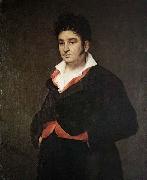Wholesale Oil Painting No Minimum |
|||||||||||
|
|
|||||||||||

|
|||||||||||
|
|
|
||||||||
Francisco de goya y Lucientesb. March 30, 1746, Fuendetodos, Spain--d. April 16, 1828, Goya is considered the 18th Century's foremost painter and etcher of Spanish culture, known for his realistic scenes of battles, bullfights and human corruption. Goya lived during a time of upheaval in Spain that included war with France, the Inquisition, the rule of Napoleon's brother, Joseph, as the King of Spain and, finally, the reign of the Spanish King Ferdinand VII. Experts proclaim these events -- and Goya's deafness as a result of an illness in 1793 -- as central to understanding Goya's work, which frequently depicts human misery in a satiric and sometimes nightmarish fashion. From the 1770s he was a royal court painter for Charles III and Charles IV, and when Bonaparte took the throne in 1809, Goya swore fealty to the new king. When the crown was restored to Spain's Ferdinand VII (1814), Goya, in spite of his earlier allegiance to the French king, was reinstated as royal painter. After 1824 he lived in self-imposed exile in Bordeaux until his death, reportedly because of political differences with Ferdinand. Over his long career he created hundreds of paintings, etchings, and lithographs, among them Maya Clothed and Maya Nude (1798-1800); Caprichos (1799-82); The Second of May 1808 and The Third of May 1808 (1814); Disasters of War (1810-20); and The Black Paintings (1820-23). |
||||||||
|
|
||||||||
Portrait of Ram
Portrait of Ram Painting ID:: 62837 |
1823 (e) Oil on canvas, 104 x 81,3 cm Rijksmuseum, Amsterdam The sitter in this painting has been identified as a nephew of JoseDuaso y Latre, the clergyman in whose house Goya took shelter in 1823 at the end of the liberal interlude. It has been suggested that the date in the inscription has been altered and that the portrait was painted not later than 1820, the last year in which Satueheld office as Alcalde de Corte (a City Councillor of Madrid). From the costume, the informal pose and the style of painting it could have been painted either in 1820 or 1823. Artist: GOYA Y LUCIENTES, Francisco de Title: Portrait of Ramen Satue , painting Date: 1801-1850 Spanish : portrait 1823 (e) Oil on canvas, 104 x 81,3 cm Rijksmuseum, Amsterdam The sitter in this painting has been identified as a nephew of JoseDuaso y Latre, the clergyman in whose house Goya took shelter in 1823 at the end of the liberal interlude. It has been suggested that the date in the inscription has been altered and that the portrait was painted not later than 1820, the last year in which Satueheld office as Alcalde de Corte (a City Councillor of Madrid). From the costume, the informal pose and the style of painting it could have been painted either in 1820 or 1823. Artist: GOYA Y LUCIENTES, Francisco de Title: Portrait of Ramen Satue , painting Date: 1801-1850 Spanish : portrait |
|||||||
|
CONTACT US |

